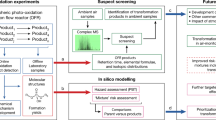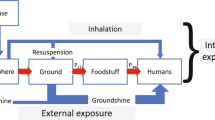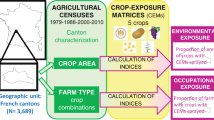Abstract
Nearly 19.5 million gallons of herbicides were sprayed on the Republic of Vietnam between 1961 and 1971 for military purposes. Amounts of spray and patterns of applications are available in an electronic file called HERBS that contains records of 9141 defoliation missions, including detailed coordinates of US Air Force Ranch Hand aircraft flight paths, along with chemical agent and gallonage sprayed. Two classes of models for use in epidemiological and environmental studies that utilize the HERBS data for estimating relative exposure opportunity indices are presented: a discrete “hits” model that counts instances of proximity in time and space to known herbicide applications, and a continuous exposure opportunity index, E4, that takes into account type and amount of herbicide sprayed, distance from spray application, and time interval when exposure may have occurred. Both direct spraying and indirect exposure to herbicide (or dioxin) that may have remained in the local environment are considered, using a conservative first-order model for environmental disappearance. A correction factor for dermal versus respiratory routes of entry has been incorporated. E4 has a log-normal distribution that spans six orders of magnitude, thus providing a substantial amount of discrimination between sprayed and unsprayed areas. The models improve on earlier ones by making full use of the geometry of the HERBS spray flight paths of Ranch Hand aircraft. To the extent possible so many decades after the War, the models have been qualitatively validated by comparison with recent dioxin soil and biota samples from heavily contaminated areas of Vietnam, and quantitatively validated against adipose dioxin obtained in epidemiological studies of Vietnamese. These models are incorporated within a geographic information system (GIS) that may be used, as one would expect, to identify locations such as hamlets, villages, and military installations sprayed by herbicide. In a novel application, the GIS also facilitates quantitative risk assessment in epidemiological and ecological studies by applying the models within a framework of historical reconstruction of exposure history of individuals based upon their location histories.
This is a preview of subscription content, access via your institution
Access options
Subscribe to this journal
Receive 6 print issues and online access
$259.00 per year
only $43.17 per issue
Buy this article
- Purchase on Springer Link
- Instant access to full article PDF
Prices may be subject to local taxes which are calculated during checkout




Similar content being viewed by others
References
Abbott I.M., Bonsall J.L., Chester G., Hart T.B., and Turnbull G.J. Worker exposure to a herbicide applied with ground sprayers in the United Kingdom. Am Ind Hyg Assoc J 1987: 48: 167–175.
Brody J.G., Vorhees D.J., Melly S.J., Swedis S.R., Drivas P.J., and Rudel R.A. Using GIS and historical records to reconstruct residential exposure to large-scale pesticide application. J Expos Anal Environ Epidemiol 2002: 12: 1–17.
Cyranoski D. US and Vietnam join forces to count cost of Agent Orange. Nature 2002: 416: 262.
Data Management Agency U.S. MACV. Herbicide Report System (HERBS). Document No. DARU07 (US Military Assistance Command, Vietnam. San Francisco: Headquarters, 1970.
Draper W.M., and Street J.C. Applicator exposure to 2,4-D, dicamba, and a dicamba isomer. J Environ Sci Health B 1982: 17: 321–339.
Dwernychuk L.W., Cau H.D., Hatfield C.T., Boivin T.G., and Hung T.M., et al. Dioxin reservoirs in southern Viet Nam — a legacy of Agent Orange. Chemosphere 2002: 47: 117–137.
Gunier R.B., Harnley M.E., Reynolds P., Hertz A., and Von Behren J. Agricultural pesticide use in California: pesticide prioritization, use densities, and population distributions for a childhood cancer study. Environ Health Perspect 2001: 109: 1071–1078.
Ha M.C., Cordier S., Bard D., Le T.B., Hoang A.H., Hoang T.Q., Le C.D., Abenhaim L., and Nguyen T.N. Agent orange and the risk of gestational trophoblastic disease in Vietnam. Arch Environ Health 1996: 51: 368–374.
Harrigan E.T. Calibration Test of the UC-123K/A/A45Y-1 Spray System. Technical Report ADTC-TR-70-36. Armament and Development Test Center, Eglin AFB Florida, February, 1970.
Institute of Medicine. Committee to Review the Health Effects in Vietnam Veterans of Exposure to Herbicides. Veterans and Agent Orange: Health Effects of Herbicides Used in Vietnam. National Academy of Sciences Press, Washington, DC, 1994.
Institute of Medicine. Veterans and Agent Orange: Update. National Academy of Sciences Press, Washington, DC, 1996.
Institute of Medicine. Committee on the Assessment of Wartime Exposure to Herbicides in Vietnam. Characterizing Exposure of Veterans to Agent Orange and Other Herbicides Used in Vietnam: Scientific Considerations Regarding a Request for Proposals for Research. National Academy of Sciences Press, Washington, DC, 1997.
Institute of Medicine. Veterans and Agent Orange: Update. National Academy of Sciences Press, Washington, DC, 1998.
Institute of Medicine. Veterans and Agent Orange: Update 2000. National Academy Press, Washington, DC, 2001.
Kramarova E., Parkin D.M., Anh C.T., Tran V.A., Phan V.N., Xuan L.V., Raphael M., Rivera-Pomar J.M., Stellman S.D., Hung J.-C., Kogevinas M., Cordier S., Cau H.D., and Hung N.C. Case–control study of soft-tissue sarcomas and non-Hodgkin lymphomas in relation to exposure to herbicides in Vietnam. Paper presented at Vietnam–United States Scientific Conference on Human Health and Environmental Effects of Agent Orange/Dioxin, Hanoi, March 2002.
Libich S., To J.C., Frank R., and Sirons G.J. Occupational exposure of herbicide applicators to herbicides used along electric power transmission line right-of-way. Am Ind Hyg Assoc J 1984: 45: 56–62.
National Research Council Committee on the Effects of Herbicides in Vietnam. The Effects of Herbicides in South Vietnam; Part A. Summary and Conclusions. National Academy of Sciences Press, Washington DC, 1974.
Phan V.N. Proposals for improving the scientific credibility of dioxin exposure index estimations. Paper presented at Second Seminar on Medical Informatics, Institute of Information Technology, Vietnam National Center for Natural Sciences and Technology, Hanoi, December, 1998.
Reynolds P., Von Behren J., Gunier R.B., Goldberg D.E., Hertz A., and Smith D.F. Childhood cancer incidence rates and hazardous air pollutants in California: an exploratory analysis. Environ Health Perspect 2003: 111: 663–668.
Schaeffner E.S., Miller D.P., Wain J.C., and Christiani D.C. Use of an asbestos exposure score and the presence of pleural and parenchymal abnormalities in a lung cancer case series. Int J Occup Environ Health 2001: 7: 14–18.
Schecter A., Dai L.C., Papke O., Prange J., Constable J.D., Matsuda M., Thao V.D., and Piskac A.L. Recent dioxin contamination from Agent Orange in residents of a southern Vietnam city. J Occup Environ Med 2001: 43: 435–443.
Smith K.R. Place makes the poison: Wesolowski Award Lecture – 1999. J Expos Anal Environ Epidemiol 2002: 12: 167–171.
Stellman S.D., and Stellman J.M. Health Problems Among 535 Vietnam Veterans Potentially Exposed to Toxic Herbicides. Paper presented at Society for Epidemiologic Research, Minneapolis, June 15, 1980.
Stellman S.D., and Stellman J.M. Methodology for estimating exposure of Vietnam veterans to Agent Orange. Paper presented at American Public Health Association, Montreal, November 16, 1982.
Stellman S.D., and Stellman J.M. Estimation of exposure to Agent Orange and other defoliants among American troops in Vietnam. A methodological approach. Am J Ind Med 1986: 9: 305–321.
Stellman S.D., Stellman J.M., and Sommer Jr J.F. Combat and herbicide exposures in Vietnam among a sample of American Legionnaires. Environ Res 1988: 47: 112–128.
Stellman J.M., Stellman S.D., Christian R., Weber T., and Tomasallo C. The extent and patterns of usage of Agent Orange and other herbicides in Vietnam. Nature 2003a: 422: 681–687.
Stellman J.M., Stellman S.D., Weber T., Tomasallo C., Stellman A.B., and Christian Jr R. A geographic information system for characterizing exposure to Agent Orange and other herbicides in Vietnam. Environ Health Perspect 2003b: 111: 321–328.
Teske M.E., Bowers J.F., Rafferty J.E., and Barry J.W. FSCBG: an aerial spray dispersion model for predicting the fate of released material behind aircraft. Environ Toxicol Chem 1993: 12: 453–464.
Teske M.E. An introduction to aerial spray modeling with FSCBG. [Forest Service Cramer-Barry-Grim.]. J Am Mosq Control Assoc 1996: 12 (2 Partt 2): 353–358.
Teske M.E., Bird S.L., Esterly D.M., Curbishley T.B., Ray S.L., and Perry S.G. AgDRIFT: a model for estimating near-field spray drift from aerial applications. Environ Toxicol Chem 2002: 21: 659–671.
US Army & Joint Services Environmental Support Group. Services Herbs Tape — A Record of Helicopter and Ground Spraying Missions, Aborts, Leaks, and Incidents. Washington DC: DAAG-ESG, 1985.
Verger P., Cordier S., Thuy L.T.B., Bard D., Dai L.C., Phiet P.H., Gonnord M.-F., and Abenhaim L. Correlation between dioxin levels in adipose tissue and estimated exposure to Agent Orange in South Vietnamese Residents. Environ Res 1994: 65: 226–242.
Ward M.H., Nuckols J.R., Weigel S.J., Maxwell S.K., Cantor K.P., and Miller R.S. Identifying populations potentially exposed to agricultural pesticides using remote sensing and a Geographic Information System. Environ Health Perspect 2000: 108: 5–12.
Acknowledgements
This research was supported by the National Academy of Sciences Subcontract NAS-VA-5124-98-001 and USPHS Grants CA-68384 and CA-17613 from the National Cancer Institute. We thank Dr. Michael Switkes and Andrew B. Stellman for valuable conversations, and Carrie Tomasallo, Tracy Weber, Francine Benjamin, and Lt. Col. Richard S. Christian, Jr. (USAR, Ret.) for extensive contributions to construction of the databases and other study resources.
Author information
Authors and Affiliations
Corresponding author
Rights and permissions
About this article
Cite this article
Stellman, S., Stellman, J. Exposure opportunity models for Agent Orange, dioxin, and other military herbicides used in Vietnam, 1961–1971. J Expo Sci Environ Epidemiol 14, 354–362 (2004). https://doi.org/10.1038/sj.jea.7500331
Received:
Accepted:
Published:
Issue Date:
DOI: https://doi.org/10.1038/sj.jea.7500331
Keywords
This article is cited by
-
Agent orange exposure modeling: fallacies and errors
Journal of Exposure Science & Environmental Epidemiology (2014)
-
A Spatial Segmentation Algorithm for Resource Allocation in an Integrated Spatial and Networked Environment
Applied Spatial Analysis and Policy (2014)
-
Mangrove reforestation in Vietnam: the effect of sediment physicochemical properties on nutrient cycling
Plant and Soil (2010)
-
Assessing exposure to allied ground troops in the Vietnam War: A comparison of AgDRIFT and Exposure Opportunity Index models
Journal of Exposure Science & Environmental Epidemiology (2009)



